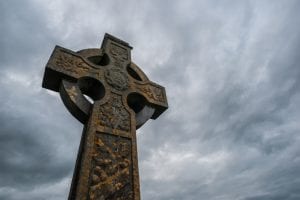Irish Wake Funeral Service Rituals
Irish Wake and Funeral Customs of Old

Wakes of times gone by began with neighbor women washing the body of the deceased and preparing it to be laid out on a bed or a table, often in the largest room of the house. The body was covered in white linen adorned with black or white ribbons and flowers for a child’s body. Lighted candles were placed around the body. Clay pipes, tobacco, and snuff were also placed in the room. Every male caller was expected to take at least a puff. The smoke kept evil spirits from finding the deceased. Usually, a pipe and tobacco placed on a table next to the body. Occasionally, a pipe was laid on the chest of the deceased male. Clocks were stopped at the time of death. Mirrors were turned around or covered.
Watching Over the Deceased and Keening
Once the body was prepared, it was never left alone until after burial. Someone, usually a woman, sat in the same room until it was taken away. According to custom, crying couldn’t begin until after the body was prepared lest it attract evil spirits that would take the soul of the departed. However, once the body was properly prepared, the keening began. The Caointhe, the lead keener, was first to lament the deceased. Keeners, especially the Caointhe, recited poetry lamenting the loss of the loved one in addition to crying and wailing. All the women in the house joined in, especially as each new caller arrived to pay his or her respects.
Mourning and Merrymaking
Wakes lasted through two or three nights. Food, tobacco, snuff, and liquor were plentiful. Out in the countryside, the liquor served consisted of whiskey or poteen, which is a very potent and illegal Irish homemade brew. Laughter, singing, and crying filled the air as mourners shared humorous stories involving the deceased. In addition to this seeming merriment, games were played. While this may appear to have been disrespectful of the dead, it was not the intention. It is thought that the merrymaking aspects of these wake customs were influenced by the Irish pagan heritage and the need to stay awake for such a long time. The church frowned upon these activities and tried hard to discourage the people from indulging in them, mostly to no avail.
No emotion was left out of the mourning process. There were debates between the extremes of tears and laughter, heartfelt poetical lamentations, and boisterous songs. As the mourners gathered around the kitchen table, poteen or whiskey-laden tea in hand, it was inevitable that discussions would begin. Often, these debates turned heated, as one might expect given that the most common topics concerned religion, politics, or economics.
Mourners Pay Final Respects
One last opportunity for friends and neighbors to pay respects to the deceased came on the morning of the funeral. The body was placed in a coffin and brought outside the house. There, the open coffin was laid across some chairs, where it remained until time to carry it to the graveyard. Mourners kiss the deceased prior to the lid being placed on the coffin.
The journey to the church and then to the graveyard was a long and arduous trip. Four of the closest relatives carried the coffin at a quick pace. They would be relieved by four more along the way, and so it went until they reached the church. After the service, the procession would continue on foot until reaching the graveside. The coffin was lowered into the grave, and the clay, the common soil in Ireland, was shoveled over it. The spade and shovel were laid on top of the new grave in the form of a cross. Prayers were said, bringing the wake and funeral to a close.
Resource:
Delaney, Mary Murray. Of Irish Ways. Dillon Press, Inc, 1973.